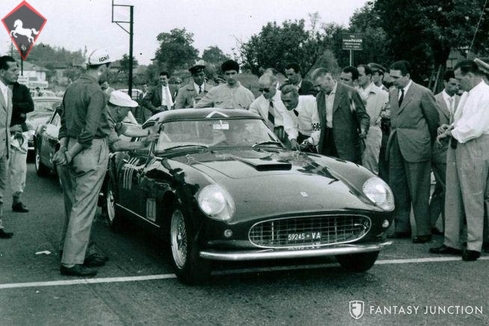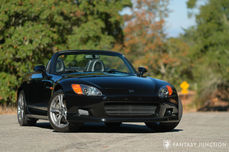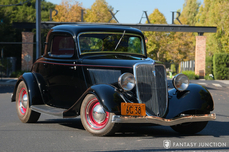Ferrari 250 GT LWB Berlinetta Tour de France 1958
General description :
1958 Ferrari 250 GT ‘Tour De France’ Alloy Berlinetta
s/n 0899 GT, Engine no. 0354 C (see Classiche)
Rosso Corsa with Brown Leather
In 1955, FIA was tasked to reclassify sports car racing in an effort to reduce the influence of grand prix technology on sports cars that were simply becoming too fast for open road courses. The new fixed displacement classes placed Ferrari and their Colombo V12 3-liter engine in an ideal position. Ferrari had a long tradition of building dual-purpose road racers, and the new Scaglietti-bodied 250 GT Berlinetta (constructed on the 2,600 mm LWB chassis) was a stunning beginning to what would become a legendary series of cars. By 1956, the 250 GT Berlinetta distinguished itself in a multitude of races, including the Marquis de Portago's victory at the new Tour de France rally in September. Shortly thereafter, Oliver Gendebien won the race in another LWB Berlinetta in 1957, and again in 1958. The versatility and reliability of these cars proved without a doubt that the 3,600-mile combination of circuits and hill climbs were of little match for the capable 250 GT.
With four consecutive victories at the French rally, this model would become affectionately known as the 250 GT Tour de France, or TdF. Ferrari would build these cars through early 1959, establishing the 250 GT TdF as one of the most desirable early racing models, and eventually rising to the pinnacle of collector status. The combination of racing prowess, impressive historic provenance, and stunning alloy Scaglietti coachwork results in one of the finest hand built cars Ferrari has ever created.
This particular single louver, covered headlight 250 GT Tour de France features a stunning and painstaking Ferrari Classiche restoration. According to Ferrari factory build sheets, the chassis was delivered to Scaglietti on February 22, 1958, with instructions to construct alloy, covered headlight coachwork, while the motor, gearbox, and rear end were assembled and completed on March 25th and 26th. Four days later the car was officially completed at the factory and prepared for delivery. During the research and restoration of this car, Ferrari Classiche verified chassis no. 0899 GT as the third example of approximately 37 single louver cars built, and the 42nd example of 77 total Tour de France Berlinettas constructed.
In early April 1958, the newly completed car was delivered to privateer racer and textile entrepreneur Eduardo Lualdi-Gabardi, a resident of Busto Arsizio. Over the following year, Lualdi-Gabardi entered 0899 GT in no fewer than thirteen races, achieving first-in-class finishes at the Coppa della Consuma and the Varese-Campo di Fiori Hill Climb. In September 1958, the Berlinetta finished third overall at the Coppa InterEuropa at Monza and second overall at the Trofeo Lumezzane. This was followed by a remarkable first overall finish at the Coppa Sant' Ambroeus at Monza in November.
In late 1958, Gabardi sold 0899 GT to Ferdinando Pagliarini who campaigned the car through the 1959 season, achieving a third-overall finish at the Coppa San Marino Hill Climb in April. A month later the Berlinetta achieved an overall victory at the Castell' Arquato-Vernasca Hill Climb, and second-in-class finishes were recorded at the Coppa della Concuma Hill Climb in June and the Pontedecimo-Giovi Hill Climb in September.
In the spring of 1960, Paul Mounier, a French resident of Algeria and president of the Lycee Techniques d'Alger (Algiers Technical School) became the new owner. Mounier, an importer of French cars in Algiers, registered the TdF in the French colony for racing use. Mounier campaigned the car in both France and Africa, finishing fourth overall at the Rallye Alger-Hassi Messaoud-Alger in April 1960, participating in the Oran Hill Climb, and finishing 7th overall at the Grand Prix de Rouen.
In 1961, having mercifully escaped the ravages of racing for two years, the car was damaged in a road accident, causing Mounier to sell the car to Marseilles garage owner Aldo Montagna. As is the case for so many of these early racing cars, the engine was dispatched to a new owner. The race-prepped experimental engine (internal no. 174 C) was sold to French shoemaker Charles Jourdan, who installed it into a second-series 250 GT Cabriolet.
Most critically, and for the benefit of history, the chassis, complete with gearbox, front and rear suspension, brakes, steering box, rear-end drive, fuel tank and the complete dash console, were preserved as a unit. In 1969, Jacques O'Hana of Marseilles purchased the chassis. O'Hana registered the car and retained possession for almost 20 years, at one point selling components to sculptor and racing enthusiast François Chevallier. At this time, Chevallier attempts to utilize a portion of the original bodywork, mating it with a 250 GT Coupe in an attempt to create a replica TdF, while unfortunately stamping the replica as 0899 GT. For a period of time, two cars claimed the 0899 origin, while both the replica and the original chassis existed. Eventually, Chevallier sells the original components back to O'Hana, who in turn sells them to Michel Ferry of Monaco in 1987. Mr. Ferry works tirelessly to promptly end the replica's erroneous claims to 0899 GT by reportedly obtaining a letter through Ferrari France's F40 LM team manager Jean Sage explaining the chassis' actual history, and the false stamping used on the replica car.
Ferry retains possession of the legitimate car and in 1990 commissions the creation of proper alloy coachwork by the esteemed award-winning craftsmen at Carrozzeria AutoSport in Modena, Italy. In 2012, the restoration process is taken one step further to the highest standards, entrusted to the masters at Ferrari Classiche, ensuring the utmost authenticity and historic accuracy, befitting a car of this stature. In addition to a comprehensive chassis restoration, a newly cast correct-specification type 128 C engine was supplied by the Ferrari factory. Ferrari stamped and authenticated the engine as 0899 GT, mating it to the original 0899 GT chassis. In February 2014, the factory certified the Berlinetta with a Ferrari Classiche Red Book asserting that the car today retains its original matching-numbers chassis (including suspension and brakes), gearbox, and Borrani wire wheels. To further verify and confirm their findings, a metallurgy test was performed during the certification process confirming the correct age of 0899GTs chassis. As part of the documentation process, copies of the Ferrari's original built sheets were retained. In the final statement of authenticity the factory confirmed, without doubt, that this car is the legitimate and singular 0899 GT as verified by Ferrari's Marco Arrighi unequivocally stating, "Your car is certified by Ferrari and it means that no other car can be recognized as chassis number 0899 GT."
During the final points of the restoration, 0089 GT was entrusted to Rod Drew and Francorchamps Ferrari Service in Costa Mesa, CA, with additional work by Rex Nguyen and Moto Technique, in order to ensure the highest possible mechanical and performance standards, as well as the finest cosmetic preparation befitting concours level scrutiny. In August 2016, 0899 GT was presented at Concorso Italiano in Monterey California, where the car won both ‘Best in Show’ and the ‘Best Ferrari’ trophy, as well as the ‘Art Center's Students' Choice’ Award. Subsequently, the TdF achieved the ‘Excellence in Class’ award at the Mar-a-Lago Concours d'Elegance held in conjunction with the 2017 Cavallino Classic.
During the past four years, this exceptional car has been on display at a prominent automotive museum. As road use had been minimal during that time, it was determined that a proper mechanical inspection and service was in order. In August 2021, this Ferrari was consigned with Fantasy Junction, and sent to Ferrari expert Patrick Ottis who inspected the engine and operating features to ensure proper operation while tending to the fuel and electrical system as needed. The carbs were cleaned, new carburetor top gaskets installed, mechanical fuel pump rebuilt, a new electric SU fuel pump installed. and new seal rings installed on the fuel rail. The car tested for proper operation at idle and on throttle. The carburetors were synchronized and adjusted, and then road tested to ensure good operation, proper engine performance, and sound driving manners.
Today this stunning Tour de France presents with an impeccable restoration, absolutely correct features and components, and superb finishes throughout. The paint is beautifully done with high gloss, over expertly refined coachwork, which has been exactingly performed to correct TdF configuration. All panel gaps are smooth and even with excellent closure and fit. The removable hood has a tiny chip along the forward edge, but no other blemishes are evident. The headlight covers are correctly formed with high polished finish and correct headlamps. All trim, emblems, windshield, plexiglass side and rear windows, and lenses are beautifully restored. The correct Borrani wire wheels are properly restored using original finishes showing no scratches or bead rash, including the spare wheel and correct tire. Michelin tires are correct for the period and remain ready for street or show use. All glass appears as new as do the window garnish molding and rubber gaskets.
The interior is a journey back in time to performance racing with just enough GT flavor embodied in the leather finishes and properly stitched diamond panels. The correct leather straps and proper buckles lay out along the rear package shelf while the diamond pattern continues into the center console. The seats feature a unique and novel side bolstering construction, allowing more lateral support in cornering (a relatively new feature for cars of this period). The door panels are finely finished with leather, adorned with window cranks, door handles, and delicately sculpted door pulls. The correctly finished black crinkle dashboard houses an array of excellent instruments with highly contrasting dial faces and wonderfully restored nomenclature. An array of correct toggle switches and accessory features continue to delight the eye. The beautifully restored steering wheel stands proud, emblematic of the Ferrari brand, while paying homage to the heritage of great cars that contribute to this lineage of sports cars. Overall the interior presents excellent finishes with little to no signs of use, only as intended when driven to shows or special events.
Under the hood the engine is simply stunning. Every aspect of the car has been correctly researched and refinished in order to present the car as accurately as possible. Attention to detail includes correct fasteners, proper fuel and brake lines, correct finishes to the cam covers, proper engine compartment finishes, and correctly finished raw castings. The carburetor air pan is also correctly formed allowing for better air flow and heat dissipation, per the original design. Correct Weber carburetors, ignition, and proper exhaust have all been sourced and finished per original specifications.
This exceptional Tour de France is accompanied by a tool roll and owner's manual, and an impressive collection of trophies, including the 2016 Concorso Italiano 'Best of Show' trophy, the 2016 Concorso Italiano ‘Best Ferrari” trophy, the 2016 Art Center 'Student Choice' trophy, and the 2017 Mar-a-Lago 'Excellence in Class' trophy. Also included is the impressive 1959 'Coppa San Marino' trophy from 0899 GT's 1959 3rd place finish. This Ferrari is presented with copious documentation first with the Ferrari Classiche Red Book, accompanied by a thick binder of vintage photos, former registration information, and former owner's correspondence. The restoration file is equally impressive, with an abundance of receipts from Ferrari Classiche totaling in excess of $700,000.00, Rex Nguyen, with records totaling over $130,000.00, Moto Technique, O’Rouke Coach Trimmers and UK Hide, totaling over $170,000.00, and Dennison International, Beckman, and FAI, totaling over $64,000.00. In all, recent restoration costs totaled an impressive and worthy $1,076,230.00
This striking covered headlight, alloy bodied Tour de France is a phenomenal piece of racing history, representing the best of vintage Maranello race cars. 0899 GT would be welcomed at any fast-paced vintage car rally such as the Colorado Grand, vintage racing events, such as the Goodwood meets, Monterey Reunion or Monaco Historic Races. Restored by absolute experts to exquisite condition, 0899 GT remains ready to delight the next fortunate owner with a new chapter of renewed excellence, spirited driving, and the awe inspiring impact of being an ongoing part of GT racing history.
https://fantasyjunction.com/inventory/1958-ferrari-250-gt-tour-de-france-alloy-berlinetta/overview
1958 Ferrari 250 GT LWB Berlinetta Tour de France is listed sold on ClassicDigest in Emeryville by Fantasy Junction for Not priced.
Car Facts
Car type : Car Make : Ferrari Model : 250 GT LWB Berlinetta Tour de France Engine size : 3.0 Model Year : 1958 Sub type : Race/Rally Car Location : Emeryville Vehicle Registration : Normal
Sold
Seller Information
Sold
Other cars listed for sale by this dealer
About Ferrari
The first Ferrari road car was the 125 S introduced in 1947 and powered by a 1.5 L V12 engine, right? Well it's not quite that simple, Ferrari did in fact produce e Tipo 815, in 1940. Tipo 815 was designed by ex-Alfa Romeo engineers Alberto Massimino and Vittorio Bellentani and by Enrico Nardi under Enzo's company but legal issues with the former associate Alfa Romeo prevented Ferrari from launching the Ferrari marque at that point.
Enzo did produce a series of fine road cars in the 50's and 60's but they were merely to finance his true passion racing, wheather GT/Sports car or Grand Prix. The 50's saw the birth of Ferrari's most memorable cars, 250 GTB (tour de France) 250 Testa Rossa, 250 GT swb just to name a few.
Under the surface tension was growing though. In November 1961 long-time sales manager Girolamo Gardini made an ultimatum to Enzo: if tensions continued, he would leave the company. As a result, Gardini was ousted, as well as Scuderia Ferrari manager Romolo Tavoni, chief engineer Carlo Chiti, experimental sports car development chief Giotto Bizzarrini, and a number of others who stood by them.
Without Chiti and Bizzarrini the development of what was to become the most quintessential Ferrari and today the world's most expensive car, 250 GTO, was at a pivoting point. 250 GTO project was saved by a young engineer Mauro Forghieri and long-time racing bodyman Sergio Scaglietti who stepped in and took over the program with known results.
In addition to 250 GTO, Ferrari launced such master pieces as 250 LM, 250P, 275 GTB, 365 GTB/4 "Daytona" during the the 60's
By the late 60's Ferrari's prototypes' success came to a sudden halt by a new competitor, GT40. Ford turned to Lola to produce a Ferrari beating long distance racer after Enzo had cut the deal off with Henry Ford II making the latter absolutely boil with fury. The collaboration between Ford and Lola created the mighty Ford GT40 that gave Ferrari some heavy hits in Le Mans 24 to come.
By the end of the 60's FIAT purchased 50% of the company, starting a development that has led to a new mass-produced era of Ferraris.
Whether you are selling or looking for a classic Ferrari www.classicdigest.com is the place to check out.




















